The Supermicro 1023US-TR4 is a 1U server designed for organizations looking for a high-end solution in environments that can benefit from dense compute power like virtualization and cloud computing. The 1024US-TR4 comes equipped with an H11DSU-iN motherboard, which features dual-socket support for AMD EPYC series processors and up to 8TB Registered ECC DDR4 3200MHz SDRAM via its 32 DIMM slots.
The EPYC 7002 CPUs are clearly a good choice for this server, as this performance-driven CPU is specifically designed for enterprise applications, virtualized and cloud computing environments, software-defined infrastructure, high-performance computing, and data analytic applications. The CPUs are also a significant upgrade from previous models, as we’re seeing them simply dominate performance benchmarks across many systems in our data center.
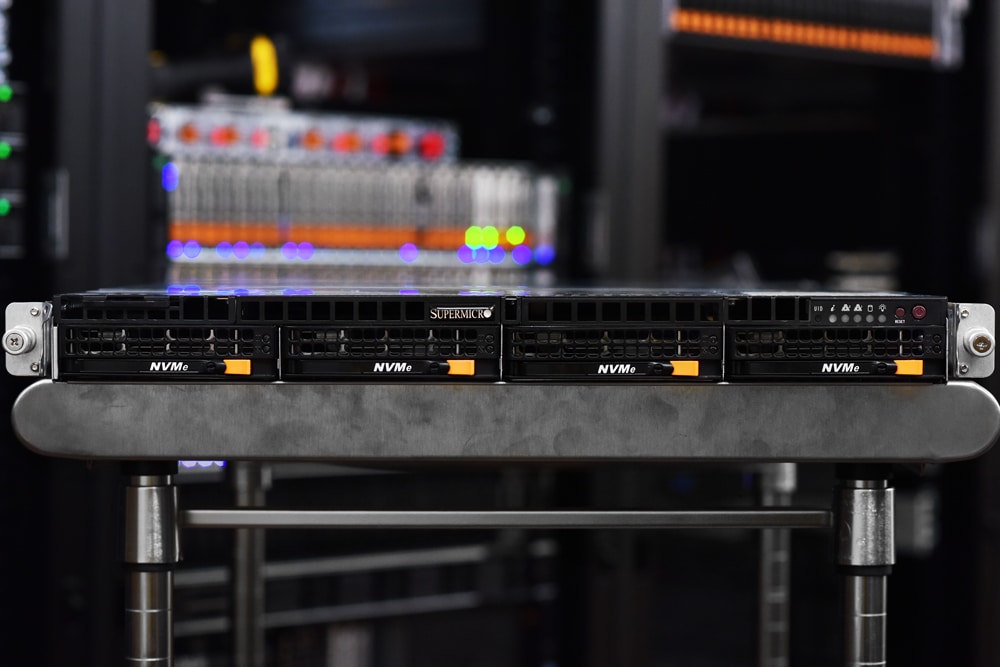
Storage-wise, the Supermicro 1023US-TR4 features four 3.5″ Hot-swap drive bays that can be outfitted with SATA, SAS, or NVMe. The combo of 3.5″ bays and NVMe is a bit curious, but Supermicro has a tendency to create interesting/flexible system builds. In this case, Supermicro is assuming users may want to combine some mix of high-speed flash and HDDs, or they simply offered it in a 3.5″ NVMe SSD configuration because they can. That’s good enough for us. They do offer a more dense 1U NVMe platform in the 1124US-TNRP, which offers a dozen 2.5″ NVMe bays. Both systems are part of Supermicro’s A+ Ultra family. Users can also add up to two M.2 SSDs for boot drives depending on PCIe riser configuration, in either SATA or NVMe variants.
Supermicro uses four Gigabit LAN ports via an Intel i350AM4 on board and features four expansion card slots via PCI-E x16 (two FH / 9.5″L) and PCI-E x8 (one LP, and one internal proprietary LP slot). Connectivity also includes an RJ45-dedicated IPMI LAN port, three USB 3.0 ports (one of which is Type A), and a VGA port. In addition, the 1023US-TR4 uses 1000W with PMBus in redundant PSUs to power the server.
Our build is comprised of an AMD EPYC 7742 CPU, 16 x 32GB of DDR4-3200 RAM (for a total of 512GB), four Micron 9200 NVMe SSDs (3.8TB).
Supermicro 1023US-TR4 Specifications
| Processor/Chipset | ||
| CPU |
|
|
| Cores |
|
|
| Chipset |
|
|
| Note | Certain CPUs with high TDP higher than 225W may be supported only under specific conditions. Please contact Supermicro Technical Support for additional information about specialized system optimization | |
| System Memory | ||
| Memory Capacity |
|
|
| Memory Type |
|
|
| DIMM Sizes |
|
|
| Memory Voltage |
|
|
| Error Detection |
|
|
| On-Board Devices | ||
| VGA |
|
|
| Expansion Slots | ||
| 1U |
|
|
| Input / Output | ||
| SATA |
|
|
| LAN |
|
|
| USB |
|
|
| VGA |
|
|
| SAS |
|
|
| NVMe |
|
|
| Others |
|
|
| System BIOS | ||
| BIOS Type |
|
|
| BIOS Features |
|
|
| Form Factor |
|
|
| Model |
|
|
| Dimensions | ||
| Height |
|
|
| Width |
|
|
| Depth |
|
|
| Weight |
|
|
| Front Panel | ||
| Buttons |
|
|
| LEDs |
|
|
| Drive Bays | ||
| Hot-swap |
|
|
| Backplane | ||
| HDD Backplane |
|
|
| System Cooling | ||
| Fans |
|
|
| Air Shroud |
|
|
| Power Supply | ||
| 1000W Redundant Power Supplies with PMBus | ||
| Total Output Power |
|
|
| Dimension (W x H x L) |
|
|
| Input |
|
|
| +12V |
|
|
| 12Vsb |
|
|
| Output Type |
|
|
| PC Health Monitoring | ||
| CPU |
|
|
| FAN |
|
|
| Temperature |
|
|
| LED |
|
|
| Other Features |
|
|
| Operating Environment / Compliance | ||
| RoHS |
|
|
| Environmental Spec. |
|
|
Supermicro 1023US-TR4 Design and build
The 1023US-TR4 is a 1U server designed for dense applications. Like most Supermicro servers, it also uses a tool-less rail system design. The chassis can be mounted into the server rack without much effort, as each end of the outer rail has a bracket with square pegs that easily snap into the server rack’s mounting holes.
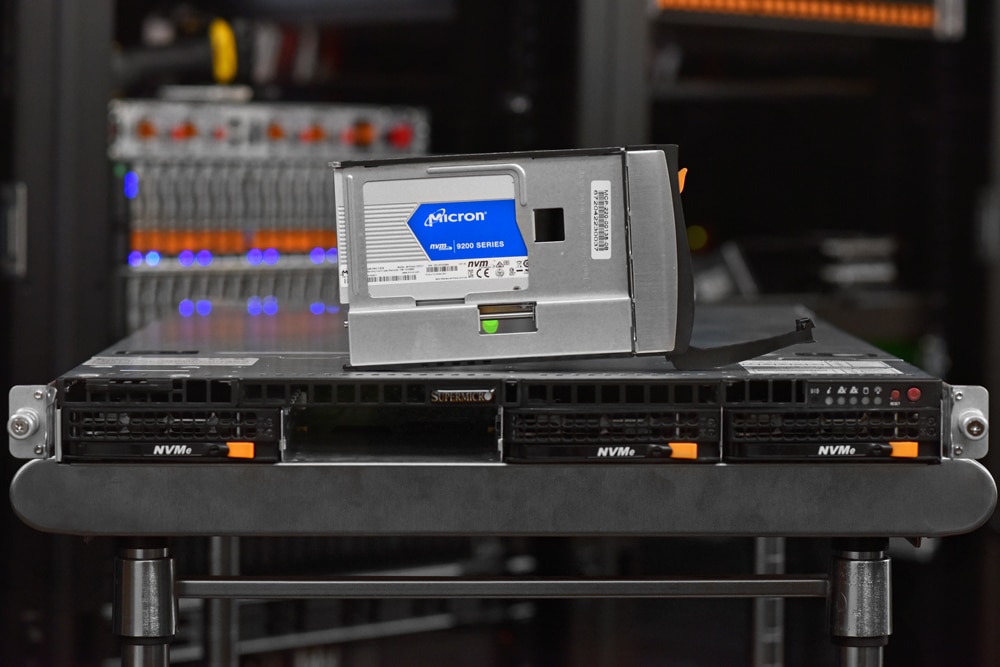
The front of the server features a control panel on the right, which has a power on/off and reset button, and six LEDs: Power, HDD, 2x NIC, information status, and UID indicators. Connectivity on the front includes two USB 2.0 ports. The four hot-swap 3.5-inch bays take up the rest of the server real estate, which feature support for SATA, NVME and SAS drives. In addition, there is an optical drive option available for those who need it, which would be added next to the service tag near the top left.
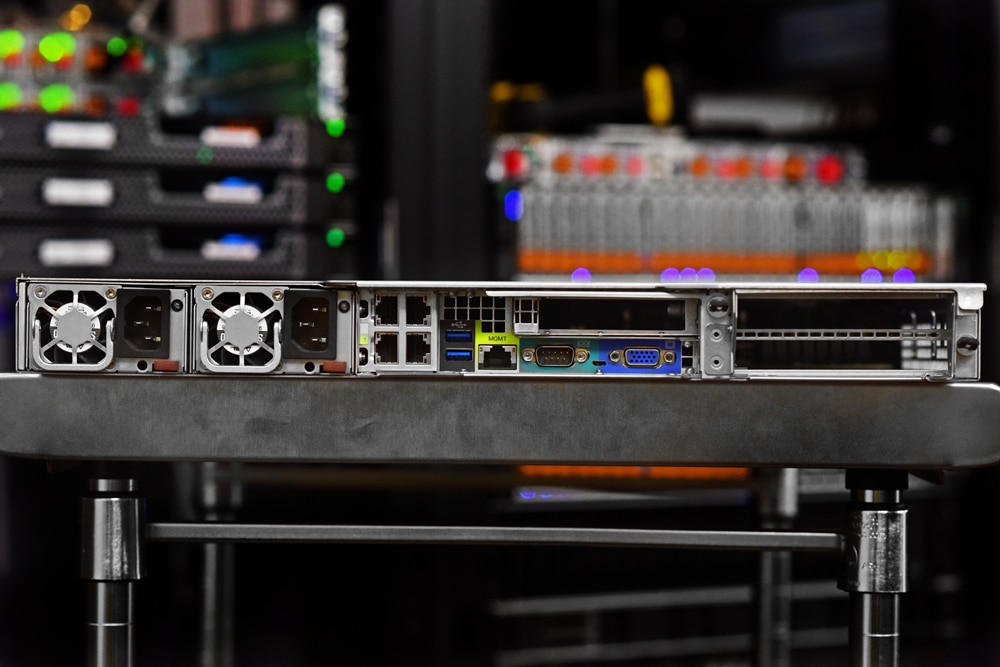
On the back panel, the server houses the redundant power supplies, the four RJ45 LAN ports, two USB 3.0 ports, a dedicated LAN port for IMPI for management and monitoring capabilities, the COM and VGA ports, two PCI slots (one PCIe low profile slot, and two PCIe full height, full-width slot).
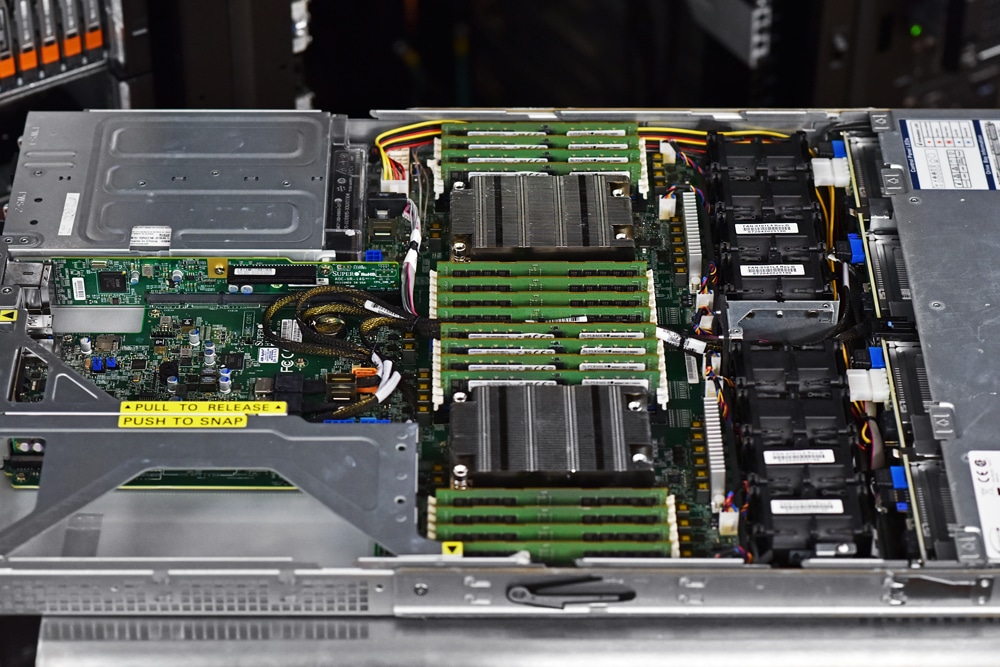
The server chassis has a removable top cover for access to the internal components. Simply press the two release buttons and slide the cover off towards the back of the server. Front and center, you will see the 32 DIMMs surrounding the dual EPYC 7200 series CPUs, which are behind the 8 internal fans that exhaust the heat out of the system. Toward the back of the motherboard resides that redundant 1000W titanium level PSUs. Overall, the 1023US-TR4 is well designed and there’s plenty of space for airflow to keep the system cool and running.
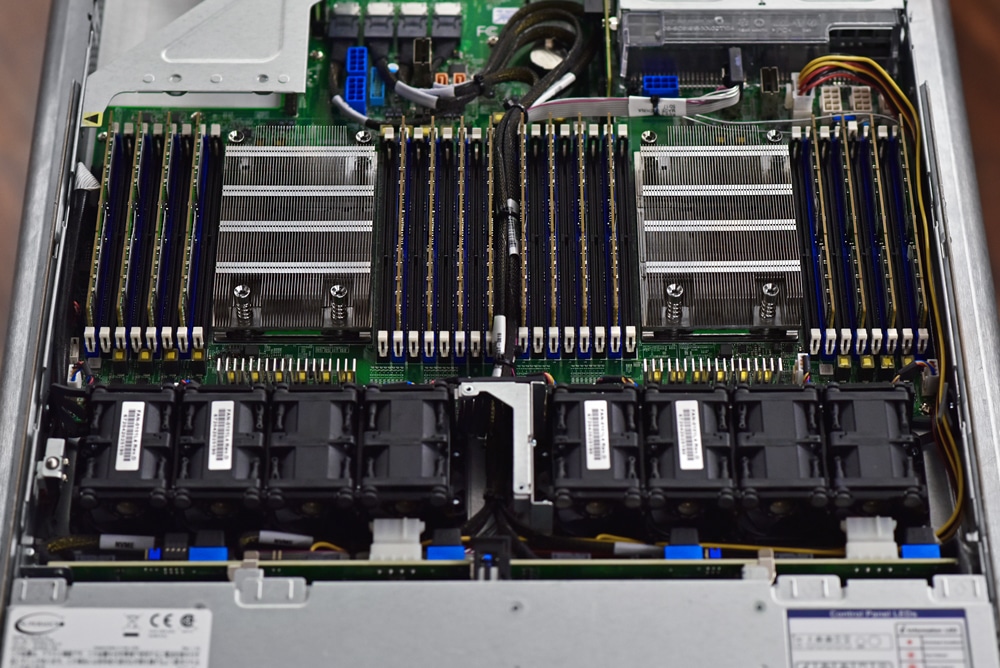
Supermicro provided us with a system block diagram as well. Here we can clearly see all the components and how they tie into each CPU.
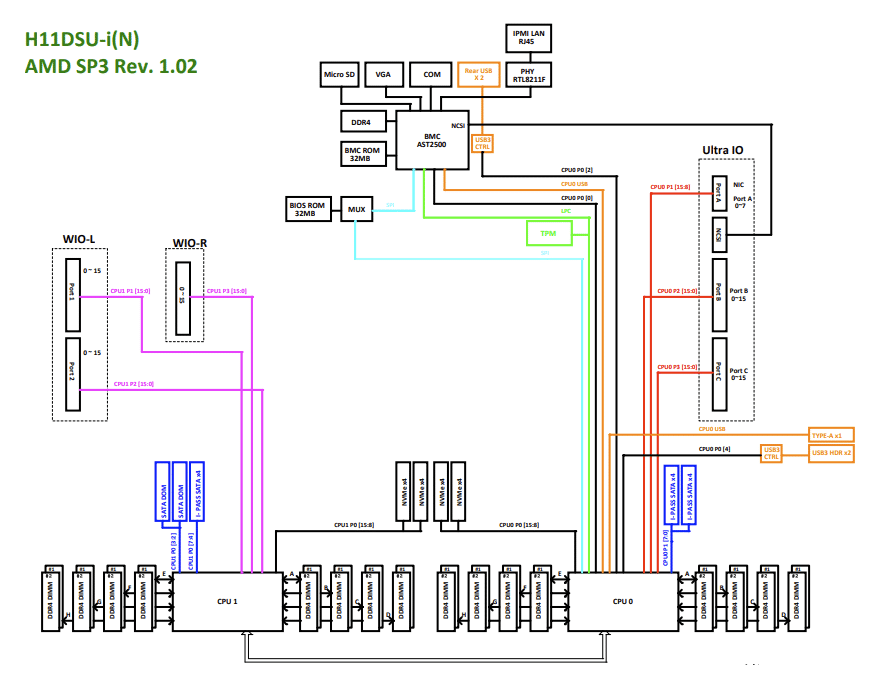
Supermicro 1023US-TR4 Performance
Supermicro 1023U-TR4 configuration:
- 1 x AMD EPYC 7742 CPU
- 512GB DDR4-3200 RAM
- VDbench Performance Storage: 4 x 3.84TB Micron 9200 (Gen3)
- SQL Server and Sysbench Storage: 4 x 3.84TB Micron 9200 (Gen3)
- Drive setup:
- Vdbench: SSDs tested in aggregate
- SQL Server: Individual datastores per SSD, VMs evenly placed across all four datastores
- Sysbench: Individual datastores per SSD, VMs evenly placed across all four datastores
- CentOS 8 (2004)
- ESXi 6.7u3
SQL Server Performance
StorageReview’s Microsoft SQL Server OLTP testing protocol employs the current draft of the Transaction Processing Performance Council’s Benchmark C (TPC-C), an online transaction processing benchmark that simulates the activities found in complex application environments. The TPC-C benchmark comes closer than synthetic performance benchmarks to gauging the performance strengths and bottlenecks of storage infrastructure in database environments.
Each SQL Server VM is configured with two vDisks: 100GB volume for boot and a 500GB volume for the database and log files. From a system resource perspective, we configured each VM with 16 vCPUs, 64GB of DRAM and leveraged the LSI Logic SAS SCSI controller. While our Sysbench workloads tested previously saturated the platform in both storage I/O and capacity, the SQL test looks for latency performance.
SQL Server Testing Configuration (per VM)
- Windows Server 2012 R2
- Storage Footprint: 600GB allocated, 500GB used
- SQL Server 2014
-
- Database Size: 1,500 scale
- Virtual Client Load: 15,000
- RAM Buffer: 48GB
- Test Length: 3 hours
- 2.5 hours preconditioning
- 30 minutes sample period
For SQL Server average latency the Supermicro 1023US-TR4 saw 1ms latency across the board and for an aggregate.

Sysbench MySQL Performance
Our first local-storage application benchmark consists of a Percona MySQL OLTP database measured via SysBench. This test measures average TPS (Transactions Per Second), average latency, and average 99th percentile latency as well.
Each Sysbench VM is configured with three vDisks: one for boot (~92GB), one with the pre-built database (~447GB), and the third for the database under test (270GB). From a system resource perspective, we configured each VM with 16 vCPUs, 60GB of DRAM and leveraged the LSI Logic SAS SCSI controller.
Sysbench Testing Configuration (per VM)
- CentOS 6.3 64-bit
- Percona XtraDB 5.5.30-rel30.1
-
- Database Tables: 100
- Database Size: 10,000,000
- Database Threads: 32
- RAM Buffer: 24GB
- Test Length: 3 hours
- 2 hours preconditioning 32 threads
- 1 hour 32 threads
With the Sysbench OLTP we saw an aggregate score of 18,353 TPS for 8VMs and 28,232 TPS for 16VMs.
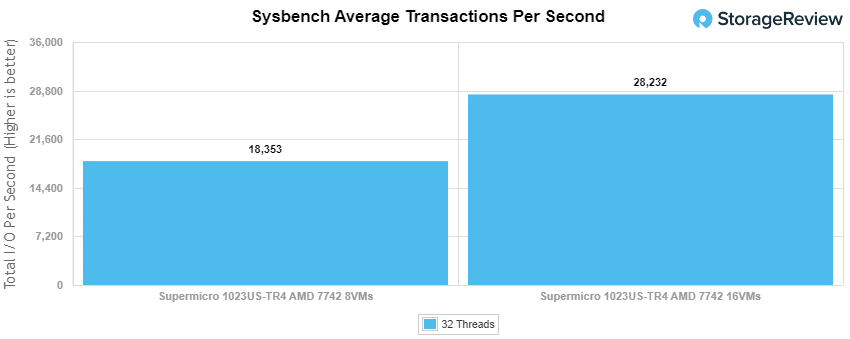
With Sysbench average latency we saw aggregate scores of 13.96ms for 8VMs and 18.2ms for 16VMs.
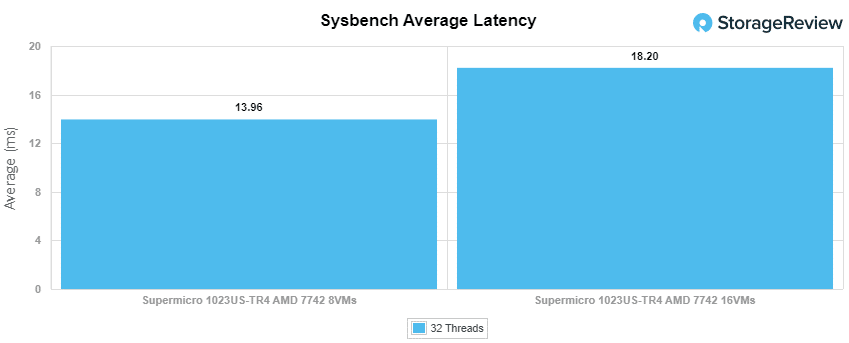
For our worst-case scenario latency (99th percentile) the SR665 had aggregate scores of 26.97ms for 8VMs and 34.21ms for 16VMs.
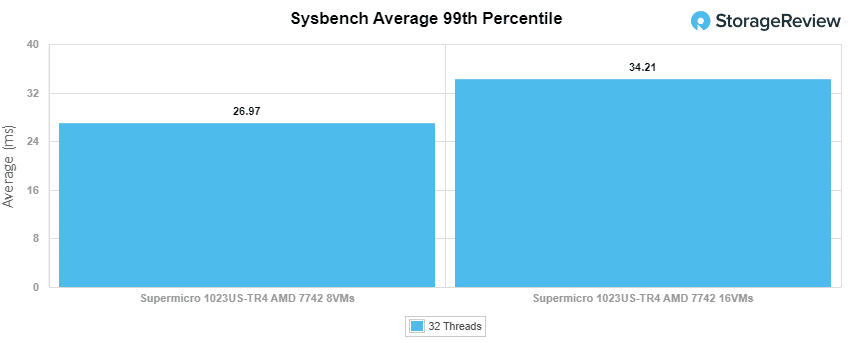
VDBench Workload Analysis
When it comes to benchmarking storage arrays, application testing is best, and synthetic testing comes in second place. While not a perfect representation of actual workloads, synthetic tests do help to baseline storage devices with a repeatability factor that makes it easy to do apples-to-apples comparison between competing solutions.
These workloads offer a range of different testing profiles ranging from “four corners” tests, common database transfer size tests, as well as trace captures from different VDI environments. All of these tests leverage the common vdBench workload generator, with a scripting engine to automate and capture results over a large compute testing cluster. This allows us to repeat the same workloads across a wide range of storage devices, including flash arrays and individual storage devices.
Profiles:
- 4K Random Read: 100% Read, 128 threads, 0-120% iorate
- 4K Random Write: 100% Write, 128 threads, 0-120% iorate
- 64K Sequential Read: 100% Read, 32 threads, 0-120% iorate
- 64K Sequential Write: 100% Write, 16 threads, 0-120% iorate
- Synthetic Database: SQL and Oracle
- VDI Full Clone and Linked Clone Traces
Looking at random 4K read, the Supermicro 1023US-TR4 recorded well below sub-millisecond latency throughout starting at 283,023 IOPS at 105.5μs while peaking at 2,910,410 IOPS with 173.7μs latency.
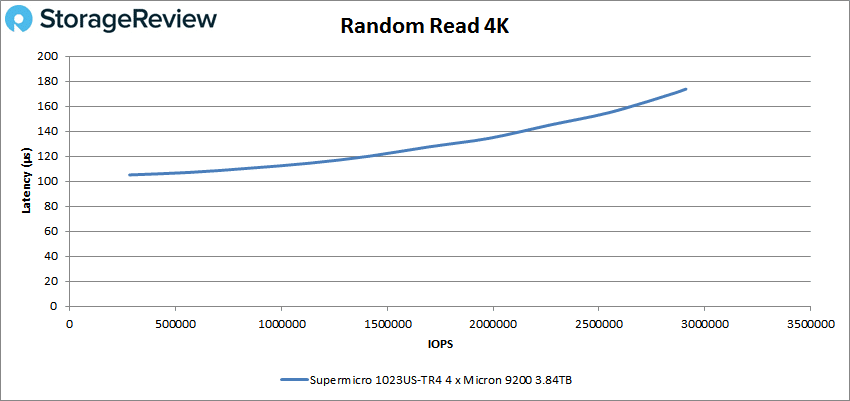
For random 4K write, the server began 184,711 IOPS with 42.1μs, which decreased in latency as the test went on until near the end of the test where it then had a huge spike that hovered around 120ms. The peak IOPS was 1,640,785.
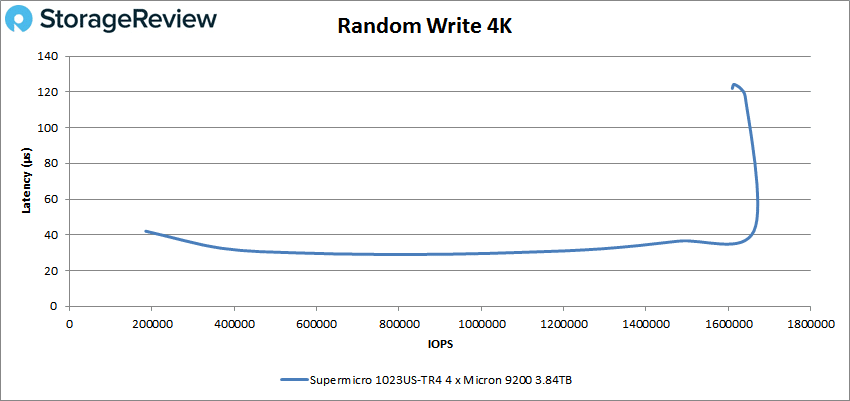
Next is sequential workloads. In 64K sequential read, the 1023US-TR4 showed sub-millisecond latency throughout with a peak of just under 200K IOPS (or 12.5GB/s) at 638μs.
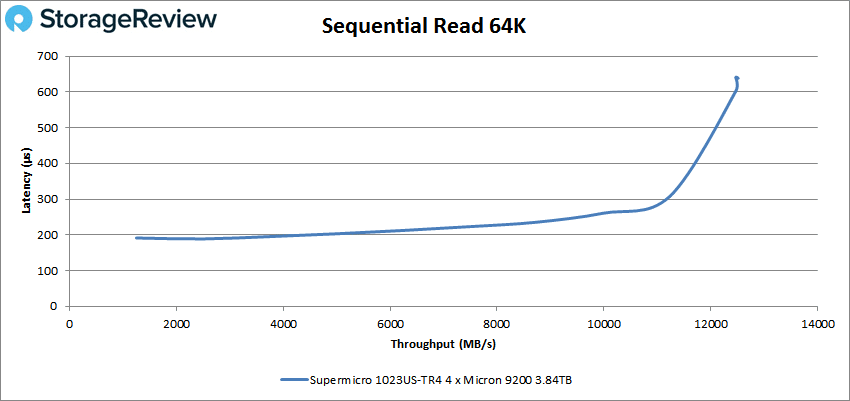
For 64K sequential write, the Supermicro server began at 19,493 IOPS (1.95GB/s) at 90.6μs latency then peaked at roughly 135,781 IOPS or 8.49GB/s at 388.4μs latency before taking a hit in performance.
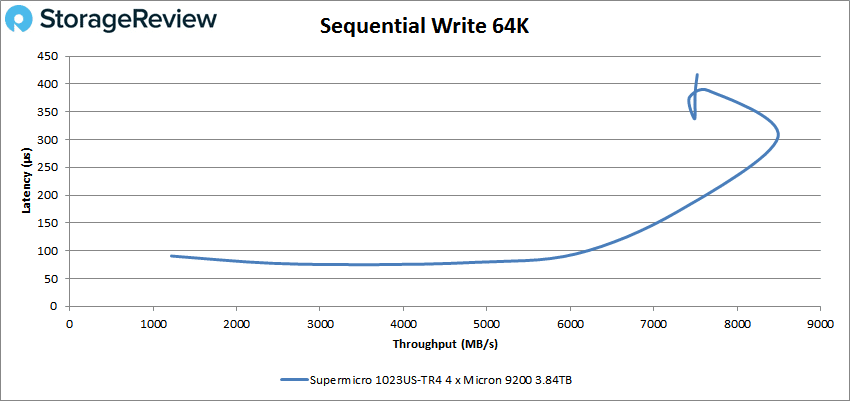
Our next set of tests are our SQL workloads: SQL, SQL 90-10, and SQL 80-20. Starting with SQL, the 1023US-TR4 peaked at 829,585 IOPS with a latency of only 153.3μs.
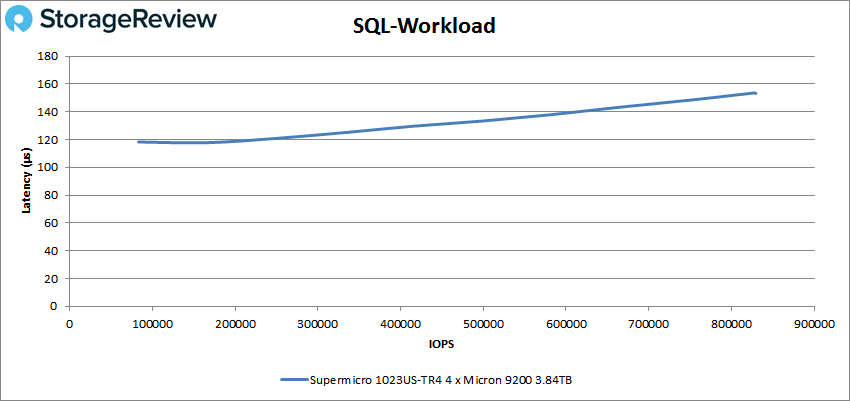
For SQL 90-10, the Supermicro server started at around 80K IOPS with a latency of 113μs and peaked at 808,015 IOPS with 156.2μs in latency.
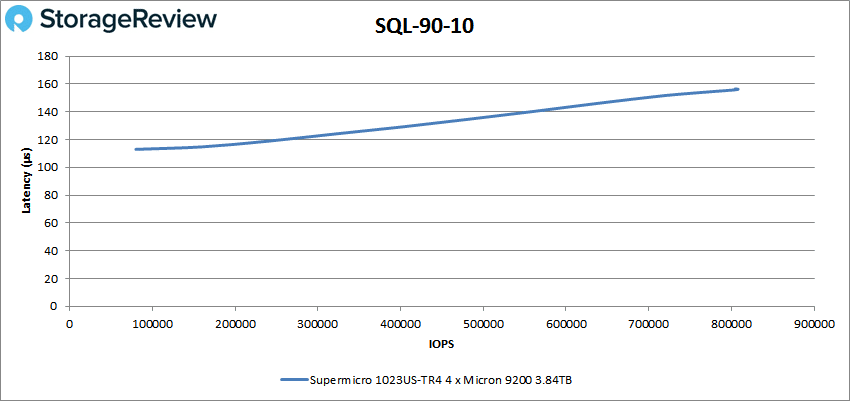
In SQL 80-20, the 1023US-TR4 peaked at 744,673 IOPS with 170.3μs in latency.
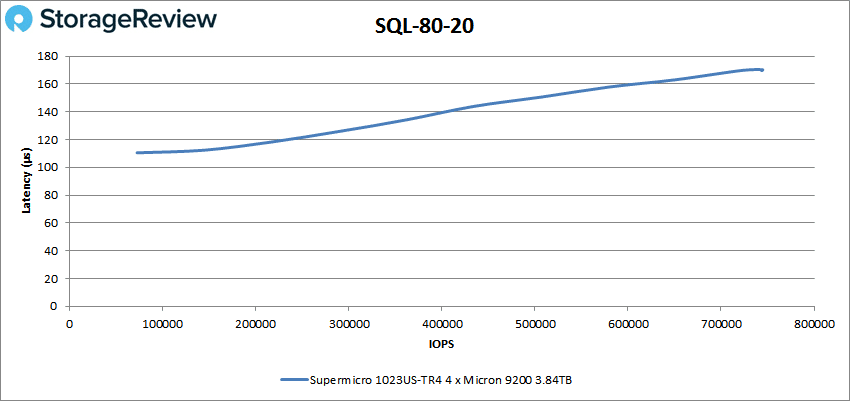
Next up are our Oracle workloads: Oracle, Oracle 90-10, and Oracle 80-20. Starting with Oracle, the 1023US-TR4 started at 108.3μs latency while peaking at 754,003 IOPS with 170.8μs in latency.
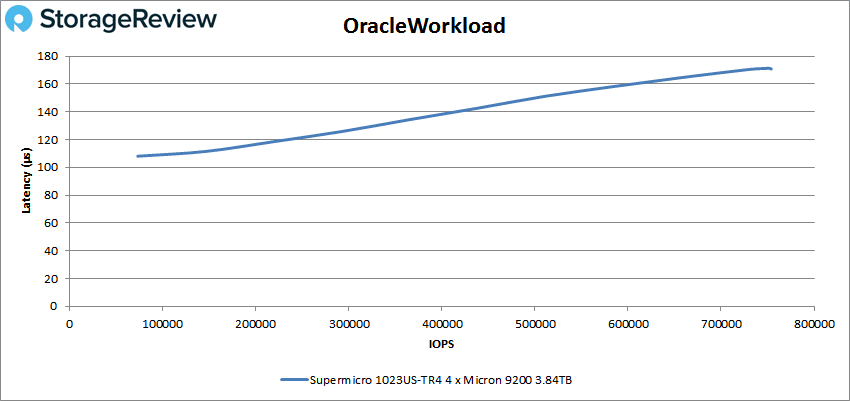
Looking at Oracle 90-10, the Supermicro server started at 64,070 IOPS with a latency of 111μs and peaked at 643,549 IOPS with 135.7μs in latency.
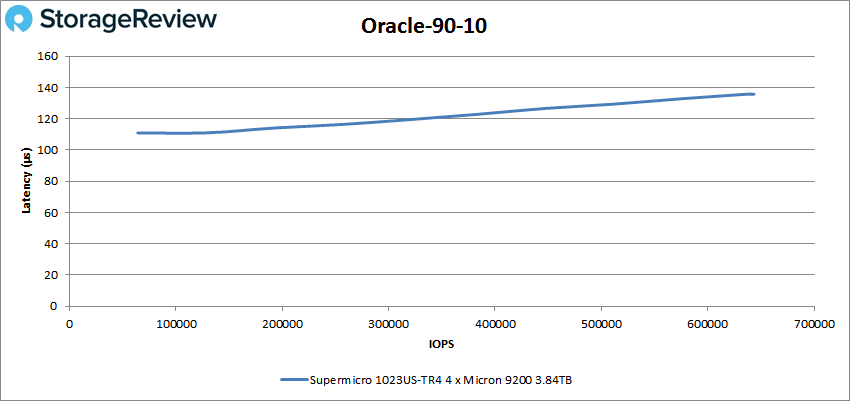
With Oracle 80-20, the 1023US-TR4 began at 60,321 IOPS and a latency of 107.2μs, while peaking at 615,507 IOPS and a latency of 141.6μs.
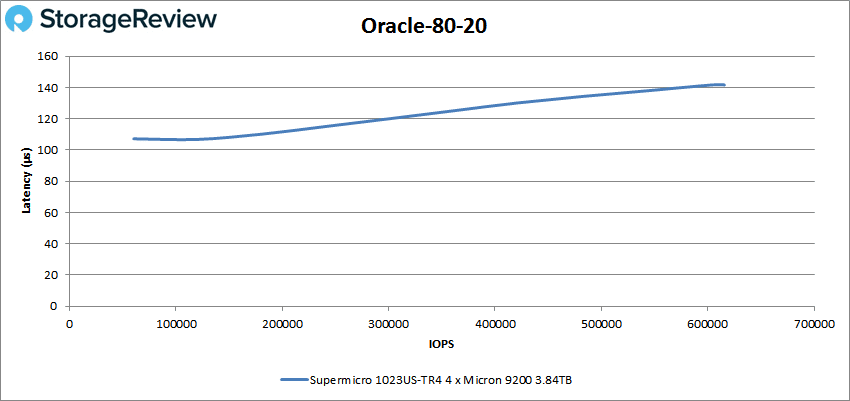
Next, we switched over to our VDI clone test, Full and Linked. For VDI Full Clone (FC) Boot, the Supermicro 1023US-TR4 began at 67,898 IOPS and a latency of 126μs while peaking at 671,954 IOPS at a latency of 190.3μs.
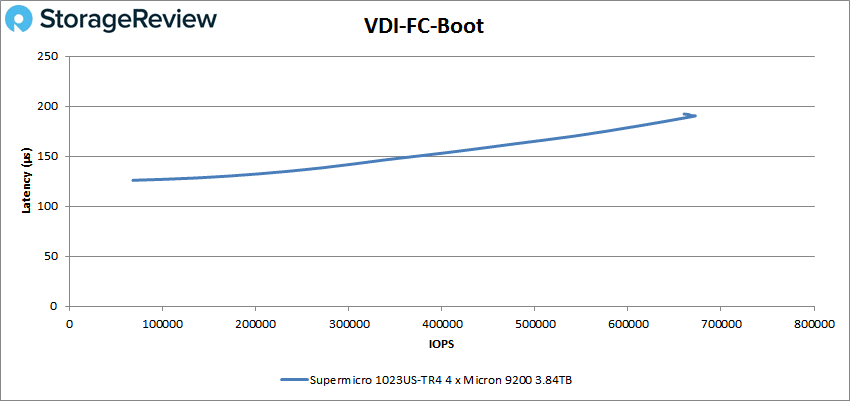
Looking at VDI FC Initial Login, the Supermicro server started at 36,184 IOPS and 111.1μs latency, hitting a peak at 351,701 IOPS at 314.2μs.
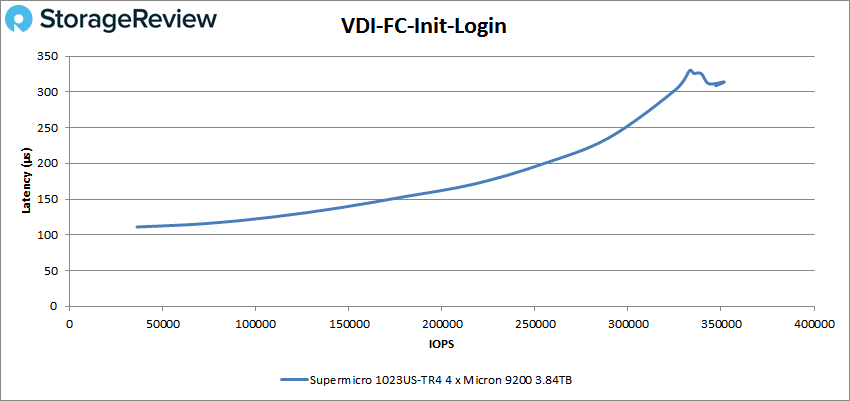
VDI FC Monday Login saw the server start at 25,762 IOPS and 122.3 μs latency while peaking at 256,180 IOPS at 230.9μs.
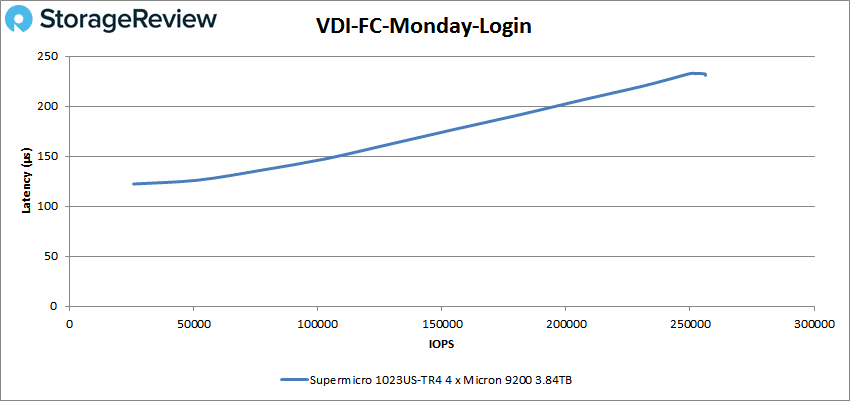
For VDI Linked Clone (LC) Boot, the 1023US-TR4 began at 33,299 IOPS with 142.4μs latency and peaked at 326,439 IOPS at 184.4μs.
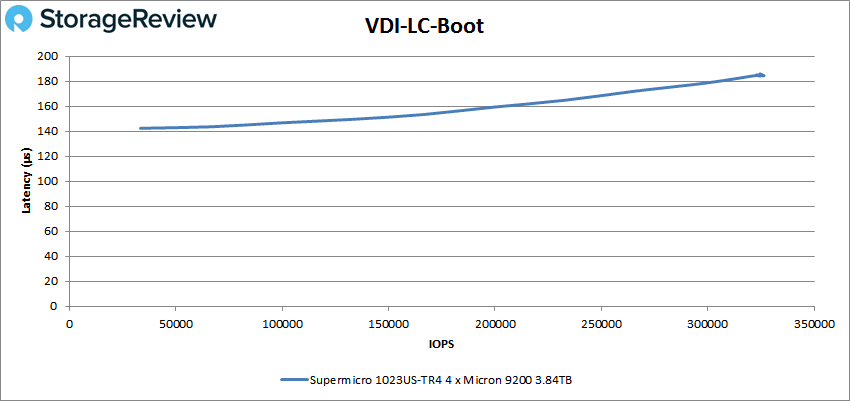
Looking at VDI LC Initial Login, the 1023US-TR4 began at 14,380 IOPS with 131.2μs latency, which then peaked at 136,416 IOPS at 209μs.
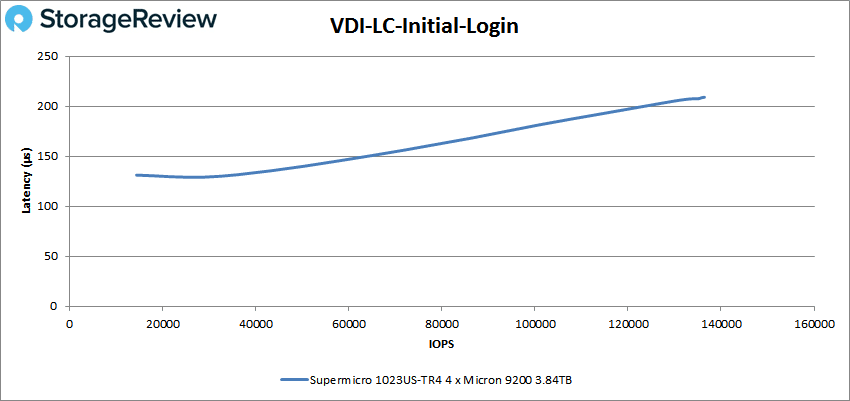
Finally, VDI LC Monday Login had the 1023US-TR4 start at 19,283 IOPS and 138μs latency while peaking at 197,662 IOPS at 296.7μs.
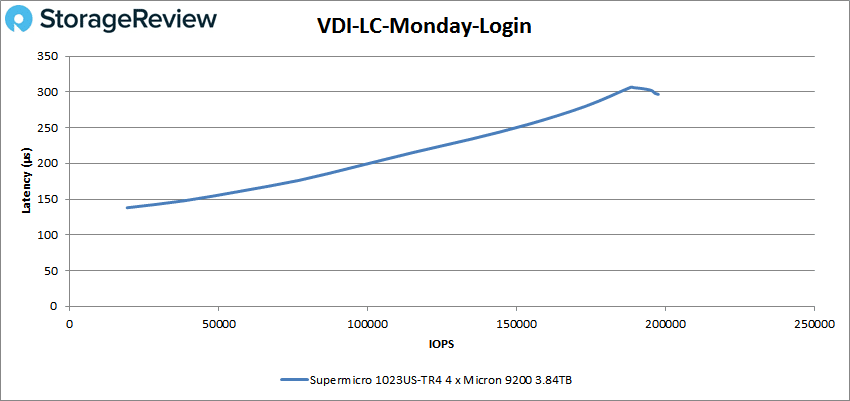
Conclusion
The Supermicro SuperStorage 1023US-TR4 is designed for organizations who need a solution for their virtualization and Cloud-computing needs. For hardware, the server’s 1U form factor build supports dual-socket AMD EPYC 7001/7002 series processors, 8TB Registered ECC DDR4 3200MHz SDRAM via its 32 DIMM slots and can be outfitted with four NVMe/SAS/SATA drives via its four 3.5″ bays. Users also have the option to add up to two M.2 SSDs. For networking, the 1023US-TR4 uses four Gigabit LAN ports onboard and comes with four expansion slots for more cards and thus more flexibility. Onboard 10G would have been nice to see so high-speed Ethernet didn’t consume a PCIe slot though.
For our Application Workload Analysis, we saw an aggregate of 1ms for SQL Server average latency. With Sysbench we saw transactional aggregate scores of 18,353 TPS for 8VMs and 28,232 TPS for 16VMs. Sysbench average latency gave us aggregate scores of 13.96ms for 8VMs and 18.2ms for 16VMs. And Sysbench worst-case scenario saw 26.97ms for 8VMs and 34.21ms for 16VMs.
With our VDBench Workload Analysis, the server was populated with four Micron 9200 NVMe 3.84TB SSDs, mix-performance drives that are designed specifically for data center workloads. Here the Supermicro 1023US-TR4 had great results with peak highlights that include 2,910,410 IOPS for 4K read, 1,640,785 IOPS for 4K write, 12.5GB/s for 64k sequential read, and 8.49GB/s for 64k sequential write.
With our SQL workloads the sever saw peaks of 829,585 IOPS, 808,015 IOPS for 90-10, and 744,673 IOPS IOPS for 80-20. With Oracle we saw peaks of 754,003 IOPS, 643,549 IOPS with 90-10, and 615,507 IOPS for 80-20. The sever continued with this great performance when we transitioned to our VDI clone test. For Full Clone, the Supermicro server recorded peaks of 671,954 IOPS in boot, 351,701 IOPS in Initial Login, and 256,180 IOPS for Monday Login. For Linked Clone, we saw 326,439 IOPS for boot, 136,416 IOPS for Initial Login, and 197,662 IOPS for Monday Login.
Overall, the Supermicro 1023US-TR4 is a 1U server that offers a lot of performance and flexibility inside its smaller form factor. Those looking for a denser solution might want to look at models like the 1124US-TNRP, which offers 12 hot-swap 2.5-inch bays in the same 1U form factor.




 Amazon
Amazon